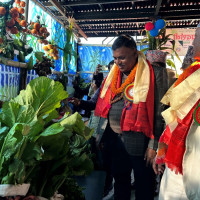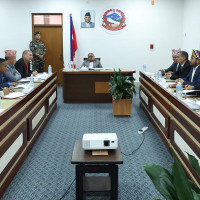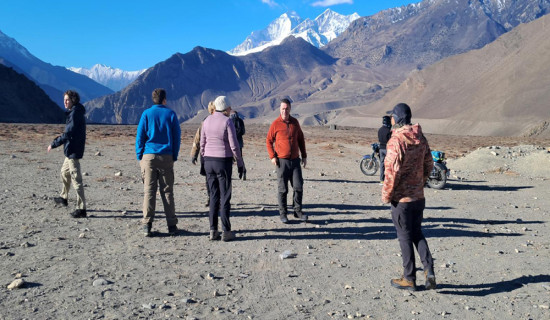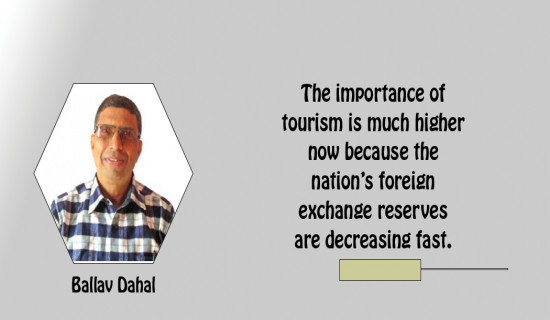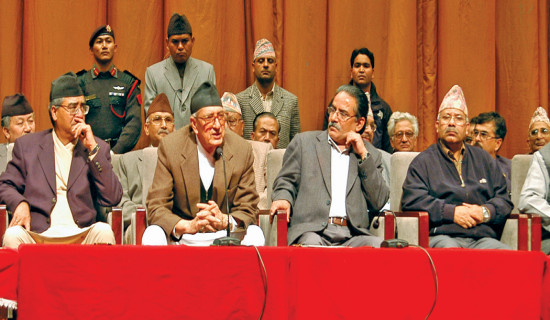- Friday, 2 January 2026
58thAnniversary Special Supplement
Growing Media Coverage On Tourism
Nepal takes centre stage in mountain tourism as the nation is home to hundreds of mountains, including Sagarmatha and the other seven peaks above 8,000 metres. An estimated 45 per cent of tourists to Nepal make their trips to the nation’s natural resources, such as snow-capped mountains, beautiful valleys, freshwater rivers, protected areas, and sub-tropical forests. It is needless to mention that the country occupies an important position on the global tourism map.
Being mostly a mountainous nation with its abundant natural resources, Nepal is famous worldwide for a myriad of adventure tourism activities like mountaineering, trekking, hiking, mountain biking, canyoning, mountain flights, skydiving, rafting, kayaking, and canoeing. Bungee jumping, paragliding, parachuting, and zip-flying are additional adventure activities. The country has also been prominent in cultural tourism and wildlife tourism. Hundreds of thousands of tourists from around the world visit here annually to explore these segments.
Respite
However, the number of tourists the nation hosts at present is insignificant as compared to the figures recorded by many other destinations globally. The number alone is also not important. What is required is a sustained rise in the number of visitors and the number of tourism receipts. Global tourism has now been on a recovery track with the disappearance of COVID-19. The pandemic had hit this multifaceted industry hard. International tourist arrivals had fallen off at an unprecedented rate in 2020, and the year followed, dealing a devastating blow to this susceptible industry worldwide. Tourism in Nepal, too, was not an exception. But this sector is now bouncing back remarkably, bringing a respite to the tourism industry and creating confidence among all tourism stakeholders.
The international news media seems to have given more coverage to momentous tourism events, especially mountaineering activities, than political incidents taking place in Nepal. Many media outlets, such as newspapers, magazines, radios, televisions, and news portals, have highlighted the country’s tourism activities on a regular basis. The nation receives good publicity and promotion worldwide through this type of media coverage.
Up until 1950, Nepal was less known to the outside world as a destination for mountaineering. When French climbers Maurice Herzog and Louse Lachenal were able to script history on mountaineering by setting their feet on Mt. Annapurna 1 on June 3, 1950, Nepal emerged in the global limelight. This was because of the massive coverage of the event by the international media. The occasion was more noteworthy than others, as it was the first human ascent of a peak above 8,000 metres. The renowned climbers were members of the 1950 French Annapurna Expedition. They were successful in exploring and scaling the world’s 10th tallest peak in a season without using supplemental oxygen.
Similarly, the international media highlighted the first human ascent of Sagarmatha (Mt. Everest) more than anything after three years. Legendary climbers Sir Edmund Hillary and Tenzing Norgay Sherpa made it to the summit of the world’s highest mountain on May 29, 1953. With that landmark mountaineering event, media coverage was so great that Nepal became familiar with a huge number of the global populace in no time, prompting many promising climbers from across the world to explore the Nepal Himalayas. Since then, the country has witnessed many more foreign expeditions to numerous mountains. As an explorer, Hillary got to the North Pole, the South Pole, and the summit of Mt. Everest. Recognising his dedicated efforts and subsequent achievements, Time named him one of the 100 most influential people of the 20th century.
Also, a philanthropist, Hillary devoted himself to helping the Sherpa community. Through the Himalayan Trust, he built many schools and some hospitals in the Khumbu Region. Various newspapers, televisions, and online news portals based in New Zealand and other countries are often found covering feature stories on Hillary’s remarkable mountaineering feats as well as her contributions to changing the face of people in Solukhumbu district.
Numerous scenic places as well as cultural heritage sites in Nepal are often listed as must-see tourist destinations by international travel guides like Lonely Planet. With such selections, the country gets its image as a tourist destination boosted internationally. Media outlets, especially those focusing on tourism and hospitality, give due coverage to the prescribed destinations, illustrating them in a positive light. Overall, the high international media coverage indicates the tourism news, especially mountaineering expeditions, to be very sellable.
As the nation’s pioneering broadsheet daily, The Rising Nepal has been covering a host of issues, including tourism activities, since its inception. While the publication could not highlight several key events associated with mountaineering up until 1965 (the publication’s launch year), it was able to capture the major expeditions that were organised after its initiation. And even today, it has continued to do so.
One of the founding objectives of this pioneering broadsheet daily is to disseminate factual information about the country and its people to the outside world in order to prevent misinformation and disinformation.
In line with that objective, this daily prioritises tourism activities and issues. Tourism is an important source of foreign exchange earnings and job creation. It aids, directly or indirectly, numerous other sectors like agriculture, livestock farming, poultry farming, and handicrafts. So, tourism deserves wider media exposure.
Contribution to jobs
In 2019, the contribution of the tourism industry to the gross domestic product (GDP) accounted for about 6.7 per cent. In that year, this sector supported more than one million direct and indirect jobs. What is more remarkable is that nearly 80 per cent of those jobs are in the most remote and resource-constrained regions. This speaks volumes about the economic importance of tourism. Meanwhile, tourism is the country’s fourth-biggest industry when it comes to employment. An analytical study report, unveiled by the Central Bureau of Statistics (CIB) about two and a half years ago, indicated that the country’s tourism sector provided 371,140 jobs. The figure signified 11.5 per cent of individuals engaged in all industries nationwide. Tourism is behind wholesale and retail trade, which contributes 30.6 per cent to jobs, while the contribution of the education sector and the manufacturing industry stands at 15.9 per cent and 15.8 per cent, respectively.
With a steady diversification of tourism within the country, most Nepali media outlets appear to have been carrying news and views on tourism issues. They also bring different tourist destinations and products to the visitors’ attention, thereby contributing to tourism promotion. They provide vital data and information about tourist arrivals, the creation of new tourism products, and the accommodation and transport facilities available in particular tourist destinations. Using such evidence, policymakers as well as authorities concerned could take the necessary steps to address the problems and inconveniences faced by visitors and tourism entrepreneurs alike.
(The author is a former Deputy Executive Editor of this daily.)




